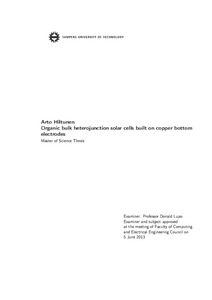Organic bulk heterojunction solar cells built on copper bottom electrodes
Hiltunen, Arto (2013)
Hiltunen, Arto
2013
Sähkötekniikan koulutusohjelma
Tieto- ja sähkötekniikan tiedekunta - Faculty of Computing and Electrical Engineering
This publication is copyrighted. You may download, display and print it for Your own personal use. Commercial use is prohibited.
Hyväksymispäivämäärä
2013-09-04
Julkaisun pysyvä osoite on
https://urn.fi/URN:NBN:fi:tty-201309131345
https://urn.fi/URN:NBN:fi:tty-201309131345
Tiivistelmä
EU obliges its member states to reduce their greenhouse gas emissions by 30 % compared to that of 1990 levels by 2020 and further 60–80 % by 2050. Electricity production using solar panels would help to fulfill this obligation. Today inorganic solar cells can easily achieve energy conversion efficiencies as high as 30 % but the high price of inorganic solar panels has not made this technology popular. Motivation for developing organic solar cell technology is that it would allow the fast manufacture of panels and this way would lead to lower solar panel market prices. The fast manufacture is achieved using the developments of printed electronics.
This thesis studies the possibility to manufacture organic solar cells on copper electrodes. The Organic Electronics research Group of Tampere University of Technology has successfully manufactured printed organic diodes on copper since 2009. Because solar cell is a diode, we wanted to study the suitability of copper as a solar cell electrode material. We studied the manufacture of solar cells directly on copper but also zinc oxide, cesium carbonate and titanium sub-oxide was tested in between the copper and the light active layer of the solar cell. The light active layer that we used was made of P3HT:PCBM blend.
This thesis studies the possibility to manufacture organic solar cells on copper electrodes. The Organic Electronics research Group of Tampere University of Technology has successfully manufactured printed organic diodes on copper since 2009. Because solar cell is a diode, we wanted to study the suitability of copper as a solar cell electrode material. We studied the manufacture of solar cells directly on copper but also zinc oxide, cesium carbonate and titanium sub-oxide was tested in between the copper and the light active layer of the solar cell. The light active layer that we used was made of P3HT:PCBM blend.
